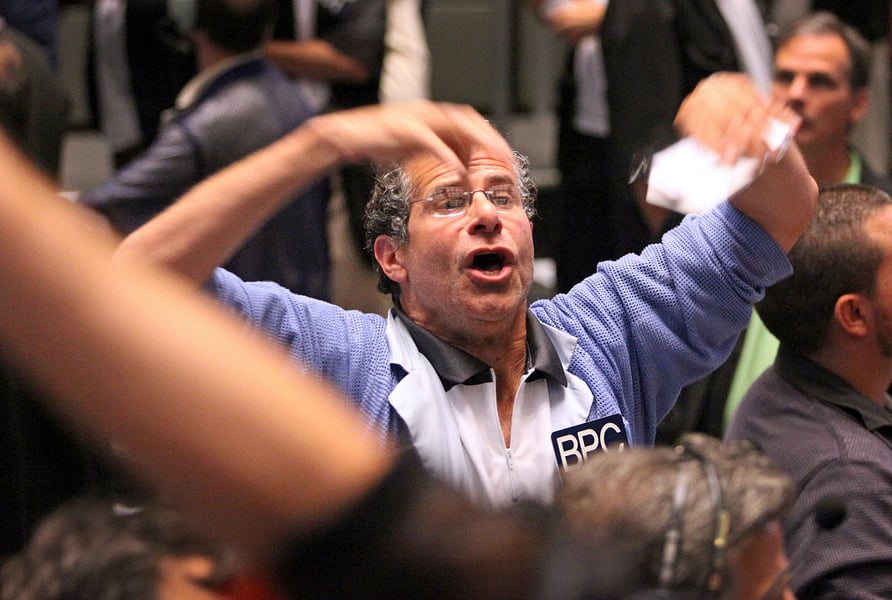Investors make a killing off stock slaughter; Pimco, Universa generate big returns
Black-swan funds run by Universa Investments LP and Pacific Investment Management Co., designed to protect against financial cataclysms, paid off this month as stocks took their steepest dive in almost three years.
Universa, run by Mark Spitznagel and advised by New York University professor Nassim Taleb, had a 10-fold return this year through Aug. 8 on the capital in its black-swan accounts, said a person familiar with the firm who asked not to be identified because the information is private. Black-swan clients of Pimco, manager of the world's biggest mutual fund, saw gains this month of as much as 5.5 times the premiums they paid, according to Vineer Bhansali, a Pimco portfolio manager.
The 13 percent decline in the benchmark Standard & Poor's 500 Index from July 29 through Aug. 8 helped bolster the case for the strategies, also known as tail-risk insurance, that hedge against rare events that can cause financial markets to collapse. Investors have tail-risk coverage for about $38 billion in assets, compared with less than $500 million prior to the September 2008 collapse of Lehman Brothers Holdings Inc., according to an April research report by JPMorgan Chase & Co.
“Given the huge move in the markets, a lot of investors, especially fast-money investors, must have been caught off guard,” said John-Mark Piampiano, a portfolio manager at Pine River Capital Management LP, a Minnetonka, Minnesota, firm that runs the $160 million Nisswa Tail Hedge Master Fund Ltd. “At this point, everyone is trying to buy protection in some form or another.”
Cost Issue
Taleb made the case for tail-risk insurance through his 2007 best-seller “The Black Swan,” whose title is a reference to a widely held Western belief that all swans were white -- until explorers discovered the black variety in Australia in 1697. He argued that high-impact, unforeseen events occur far more frequently than statistical analysis predicts, thereby justifying the high cost of hedging against disasters.
At issue is whether tail-risk events occur frequently enough to warrant the annual costs. In June, James Montier, a strategist at Boston-based Grantham Mayo Van Otterloo & Co. who is known for his bearish views on markets, published a white paper arguing that investors should simply keep some of their assets in cash rather than buy tail-risk protection.
“Anytime you are looking for a tail event to occur, it always takes longer to occur than you think,” said Paul Alar, managing director at West Mountain LLC, an Atlanta-based money manager that provides tail-risk strategies for clients. “The concern we want to avoid is buying a long-term put on something and then just watching it decay.”
Put Profits
Tail risk refers to the bell-shaped curve that represents all potential market outcomes. Most of these outcomes are in the middle of the curve, while more extreme scenarios, such as huge gains or declines, are located on the tails.
Universa, based in Santa Monica, California, trades options and futures tied to the S&P 500, including puts, which surge in value when the index declines beyond a certain level.
The firm reaped big gains on derivatives tied to the S&P 500 as the benchmark index fell almost 6.7 percent on Aug. 8, its largest one day decline since December 2008, and market volatility rose. The Chicago Board Options Exchange Volatility Index, better known as the VIX, increased for a record ninth straight time to 48 on Aug. 8, raising the value of options on stocks and indexes.
Under Universa's Black Swan Protection Protocols, customers invest capital equal to 1 percent to 5 percent of the value of assets they want to protect. Through the Aug. 8 rout, these investors had 10-fold gains for the year on their money with Universa, equating to average returns of 20 percent to 25 percent on the full value of their protected holdings, according to the person familiar with the firm's strategy.
Spitznagel declined to comment on Universa's results.
Pimco Approach
Pimco, co-founded by Bill Gross, takes a different approach. The Newport Beach, California-based firm charges clients premiums to cap losses at 15 percent to 20 percent. For a portfolio with 60 percent in stocks and 40 percent bonds, the fee would run from 1.5 percent to 2 percent of assets.
Pimco's tail-risk hedging program covers about $30 billion of assets in customer accounts, investment funds and a partnership dedicated to the strategy. These customers had gains of 4 to 5.5 times fees, according to Bhansali.
At funds such as the $4.9 billion Pimco Global Multi-Asset, the insurance program has added 3 percentage points to 5 percentage points of performance this year, according to Bhansali, the chief architect of the firm's tail-risk management program. The global multi-asset fund, co-managed by Bhansali and Mohamed El-Erian, Pimco's chief executive officer, is down about 1.1 percent so far this year, a performance that ranks among the top 9 percent of its peers, according to data compiled by Bloomberg.
Pine River
Pine River's Nisswa tail-risk fund had strong gains during the past week, leaving it in positive territory for the year, according to Piampiano, who works in the firm's New York office.
Nisswa's returns are not directly comparable to those of Pimco and Universa because its strategy is structured differently: while the two larger firms tailor their tail risk strategies to individual clients and require just a small amount of capital, Nisswa pools investor capital in a single fund that buys protection each month. The gains enjoyed by his fund and those at Pimco and Universa mean that new investors will pay a much greater price to obtain protection against Black Swans, Piampiano said.
“For anyone who wants to buy insurance at this level, the cost is very steep,” Piampiano said. “The price of insurance has roughly doubled on the equity side relative to the beginning of the year.”
--Bloomberg News--







